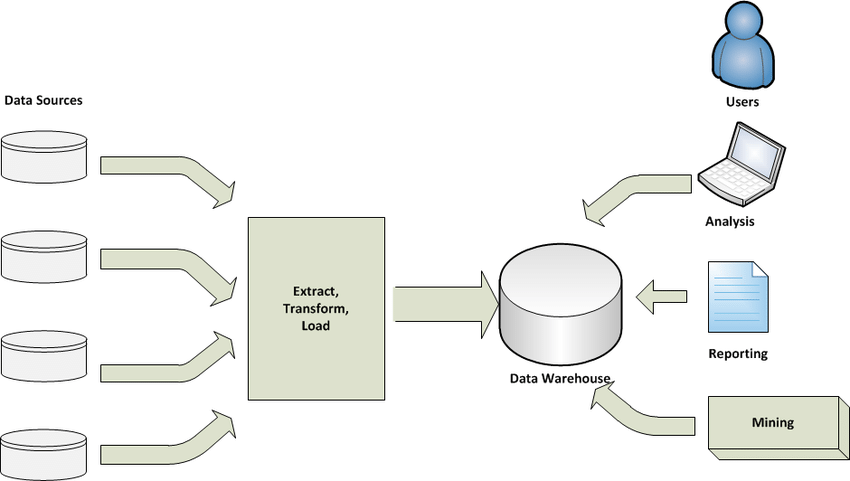
Data has become an integral part of modern businesses and helps organizations across the globe to make more-informed business decisions, optimize business operations, improve marketing campaigns, reduce costs, identify opportunities, improve ROI etc. But lack of data management can lead to inconsistent data sets, incompatible data silos, data quality problems and sets the organizations far away from making data-driven decisions. The data warehouse technology is one such tool that helps organizations in managing the business information in an organizable and easy to access manner. It eliminates all the data related challenges and streamlines organizational data management. This blog has been designed to eliminate your confusion about data warehouse tools and covers concepts like data warehouse definition, what is a data warehouse, who uses it, applications of the data warehouse, top data warehouse tools, and a lot more.
In this blog we are going to cover the following concepts in detail:
● What is a data warehouse? ● Data warehouse History ● How does Data Warehouse work? ● Types of data warehouses ● Stages in data warehousing ● Data warehouse components ● Who uses the data warehouse? ● Applications of Data warehouse ● Best practices for data warehouse implementation ● Data warehouse advantages & disadvantages ● Data warehouse tools.
What is a Data Warehouse?
In cloud computing a data warehouse system also called an enterprise data warehouse (EDW), is a system designed to collect, store and manage business information. Data warehouse acts as a medium to connect and analyze data from diversified data sources. It allows organizations to store current and historical data in an easily accessible manner. A data warehouse collects and consolidates large volumes of data from multiple sources. It comes with powerful analytical capabilities and helps business users with the right insights to make valid business decisions. The information stored in the data warehouse acts as a major resource for data scientists, business analysts, etc. The advanced data and analytical capabilities of the data warehouse system have made it an organization's “single source of truth”. A typical data warehouse consists of the below-mentioned elements:
- A relational database for data storage
- An ETL solution for preparing data ready for analysis
- Data mining and reporting capabilities
- Client tools for data visualization
- Various advanced analytical applications that work aligned with data science and AI algorithms.
Explore the world of data warehousing excellence with our Microsoft Data Warehousing Training, your gateway to advancing your career in this dynamic field.
History of Data warehouse
The concept of data warehousing came into the picture in the 1980s when IBM researchers Paul Murphy Barry Devlin created a “business data warehouse”. The main intention behind the invention of the data warehouse was to create an architecture model for transferring data from operational systems to decision support systems. This concept has minimized the data flow problems, and costs associated with it. Traditional storage systems have failed to support massive data growth and various operations such as data collection, cleaning, and consolidation of data from a wide range of sources. Following are the key milestones in the evolution of the data warehouse
- In 1960, General Mills and Dartmouth developed the terms facts and dimensions.
- In 1970, IRI and A Nielsen proposed dimensional data marts for the retail sales segment.
- In 1983, Teradata came up with a database management system to support decision support systems.
- The real concept was coined by Inmon Bill who is also considered as a father of the data warehouse. He wrote about essential elements for developing, using and managing the data warehouse.
How does a data warehouse work?
Here let's understand how a typical data warehouse works. A data warehouse may have different databases. In every database, the data is organized into columns and tables. Using columns you can define the description of data such as data field, integer, or string. Tables are the places where actual data gets stored based on the instructions of schemas. A Data Warehouse works as a central storage system where data flows from one or more data sources. Data warehouse systems collect data from regular transactional systems and other databases. It stores all types of data whether it may be structured, semi-structured or unstructured. The data entered into the warehouse systems can be processed, transformed, and organized which makes the users access the data using various business intelligence tools, spreadsheets, and SQL clients. A data warehouse system collects data from multiple sources and merges this information into a single database. It makes data mining simple and helps in identifying the patterns in data.
Types of Data Warehouse: Following are the three different types of data warehouses
1) Enterprise Data Warehouse (EDW): An enterprise data warehouse (EDW) is defined as a database or a group of databases and summarizes business information from different sources. It makes the data available to all across the organization and supports business analytics. Enterprise Data Warehouse is highly flexible and can be hosted in the cloud or on-premises. The data stored in this type of data warehouse is considered as one of the valuable assets of the businesses as it allows the organization to make more informed decisions and minimizes the risk factor.
2) Operational Data Store: An operational data store (ODS) also acts as a central repository and provides a snapshot of the various transactional systems for real-time analytics and operational reporting. It simplifies the process to combine the operational data of an organization into a single source and makes it ready for business analytics operations.
3) Data Mart: A data mart is a subset of an enterprise data warehouse. The data stored in a data mart is particularly related to a business segment like sales, purchases, finance, or marketing. Data marts speed up the business process by simplifying the access to targeted information in a data warehouse or in an operational data store. As it holds the information related to a particular business segment it allows the users to gain quality insights and make appropriate actions.
What are the stages in a Data Warehouse?
The usage and dependency of data warehouses have been growing rapidly over a period of time. Following are the general stages of a data warehouse.
Offline Operational Database: At this stage, the whole data gets copied from the operational system to an external server. All the tasks such as loading, processing and reporting of copied data are not going to impact the system operational performance.
Offline data Warehouse: Data residing in a data warehouse is constantly updated from the operational database. The information mapped and made ready to meet the business requirements.
Real-time Data Warehouse: In this stage, the data warehouses get updated when any new transaction takes place. For example, the availability of railway tickets, aeroplane tickets, etc.
Integrated Data Warehouse: In this stage, Data Warehouses gets updated on a regular basis whenever an operational system executes a transaction. After this, it generates transactions and these transactions are transferred back to the operational system.
What are the components of Data Warehouse?
A common data warehouse consists of four major components which include a database, metadata, ETL tools, and access tools. All these components are designed to make the data warehouse more effective and enable speed analysis of data.
1) Central Database This is the first and foremost component of any data warehouse and acts as a foundation. Few years back the traditional databases used to run on-premises or in the cloud. The invention of big data technologies, the requirement for real-time analytics and the reduced cost of RAM have created huge popularity for in-memory databases.
2) Load Manager The load manager component of the data warehouse takes the responsibility to collect data from multiple sources and make the data easy to access for the users. It acts as a medium to import and export data from operational systems. Load manager consists of all the applications and programs required to bring the data out of operational systems, transform it, load it into the data warehouse.
3) Warehouse Manager The warehouse manager manages all the operations that take place in the data warehouse. It executes various operations such as the creation of indexes and views, analysis of data to make sure consistency, denormalization, transformation, aggregation, merging of source data, merging of source data, archive and data backup, etc,
4) Query Manager It is also called a backend component. It executes various operations related to user queries. The query manager schedules the query execution process moreover it also directs the queries to the targeted table in a data warehouse. It also performs various other essential tasks which include improved response as well as processing times, presents data to the users in a simplified format, and stores profiles.
5) End User Access Tools: Following are the various user’s access tools:
- Data Reporting
- Application development tools
- Query tools
- EIS tools
- OLAP tools
- Data mining tools.
Who uses Data Warehouse?
Following are the users who often use data warehouse:
- Authorities who are responsible for making decisions based on data.
- Users who wish to customize the process to gain the required information from various data sources.
- Used by the people who wish to have easy access to complex data sets.
- People who wish to generate reports, charts, and grids on large sets of data.
- People who wish to discover hidden insights out of data-flows and groupings.
Data warehouse applications:
The data warehouse has become an integral part of almost all industries in order to full-fill business needs such as effective forecasting, business intelligence, analytical reporting, ability to support robust decision making. Following are some of the renowned industries which use the data warehouse
Banking: In the banking industry data warehouse is used for essential operations such as to identify the potential risk of defaulters, performance analysis of products and services, track user accounts, market research and much more.
Government: In the government sector, data warehouses play an important role to perform functionalities like to maintain and analyze tax records, to predict criminal activities from trends, fraud detection, threat assessment etc.
Education: Data warehouse platforms help educational institutions with features to store data related to students, faculty, manage student portals, integrate data sources and much more.
Healthcare: Data warehouse plays a vital role in the advancement of the healthcare industry by helping to generate patient health records, employee records, share data with NGO’s and insurance companies, medical aid services, identifying patient trends, and provide feedback to physicists on tests and procedures.
Insurance: This industry makes use of data warehouse platforms to perform operations like data analysis, maintain customer records, design customized promotions, predict changes in the industry, etc.
Manufacturing: The manufacturing industry makes use of a Data warehouse for performing various operations like to predict market changes, analyze business trends, analyze past and future data, track customer feedback, identify opportunities for constant improvement, to store data from standard resources, and to identify new business lines.
Retail: The data warehouse is used in the retail industry to perform tasks such as recording customer information, product information, track items and their promotion strategies, analyze sales, understand complaint patterns, etc.
Telecom: In this industry, the data warehouse platform is used for making sales decisions, product promotions etc.
Best practices to be followed for successful implementation of Data warehouse:
- Have a clear approach to test the accuracy, consistency and integrity of data.
- The data warehouse should be time-stamped and easy to integrate.
- While designing a data warehouse make sure that you are ready to handle integration conflicts, use the right tools and be ready to learn from mistakes.
- Try not to spend extra money on extraction, clearing and load data.
- Build a training format for training users on how to work with the data warehouse.
Benefits of a data warehouse:
Following are the numerous ways in which having a data warehouse would benefit you:
- Data warehouse allows the organizations to access all the business information from a centralized platform
- Delivers constant information about cross-functional operations.
- It helps the seamless data integration among all sources and minimizes the burden on system production.
- Drastically brings down the time required for analysis and reporting
- Data integration and restructuring makes it easier for the user to generate reports
- Helps the business to access many sources of data from a single interface.
- Data Warehouse stores historical data which enables business users to spot a trend and conduct analysis on it.
Disadvantages of data warehouse
Following are the disadvantages of data warehouse implementation:
- Difficult to cope-up with the unstructured data
- Takes a lot of time to create and implement a data warehouse system
- It’s very hard to make changes to data source schema, queries, indexes, data types and ranges.
- The data warehouse may seem simple but hard to operate by average users
- The organization has to spend a lot of time and cost to train the users
- Data warehouses outdated relatively very fast
Top Data Warehouse Tools
There is a wide range of data warehouse platforms available in the market and the following are some of the prominent tools in the market:
Microsoft Azure Synapse: It is an updated version of the Azure SQL data warehousing platform. Microsoft Azure Synapse is an innovative analytics solution that combines enterprise data warehousing with big data analytics. This platform streamlines the data querying process and supports all business needs.
Amazon Redshift: Amazon Redshift is one of the popular and widely deployed data warehouse solutions in the market. This solution has been offering advanced data management services to multiple industries ranging from startups to leading global businesses. Global organizations using Amazon Redshift are McDonald’s, Yelp, Lyft, Intuit, etc.
Google BigQuery: Google BigQuery is an easily scalable, and serverless cloud data warehouse platform. This platform comes with the advanced capabilities to fully fill the organizational data warehousing needs and enables the organizations to make more informed decisions by providing the right data insights.
Snowflake: Snowflake has disrupted the data warehouse industry with its unique architecture and data management features. It helps businesses to be more data-driven and supports delivering the best customer experience. Snowflake offers flexible pricing models to render its services to all types and sizes of businesses.
Oracle Autonomous Warehouse: Oracle autonomous warehouse is highly flexible and scales easily along with the business operations. It offers high-speed query performance and needs no additional administration. Oracle autonomous is a fully managed data warehouse service and a great choice for beginners and oracle fans.
Bottom Line
The dependency of data has been growing tremendously over the years and to handle massively growing data volumes, the data warehouse platforms are playing an important role. Data warehouse streamlines the process to view and access any source of business information and helps you with the right insights to make data-driven decisions. Choosing the right data warehouse platform that fits your business needs will surely help you grow your business.
If you are looking to build your career in the best data warehouse platform then check out our Microsoft Data Warehousing training.
Suggested blogs
Recent blogs

21 February 2025
|
06 February 2025
|